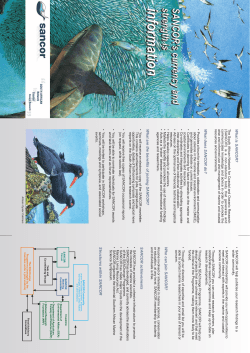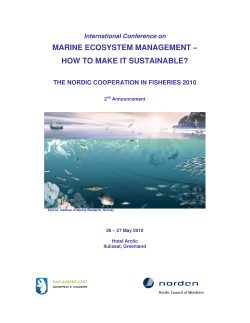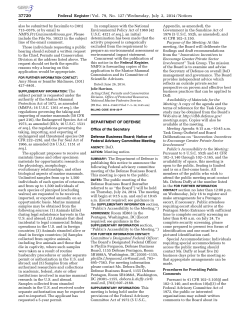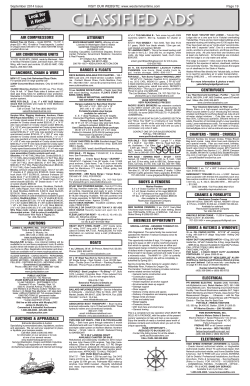
In BC waters, the sharp spines of dogfish, ratfish, rockfish,... varying degrees of toxicity. Spines can pierce gloves, boots, and...
Treatment guidelines for marine puncture wounds In BC waters, the sharp spines of dogfish, ratfish, rockfish, and sea urchins have varying degrees of toxicity. Spines can pierce gloves, boots, and hats and cause serious injury. Bacteria in spines and fish slime are serious infection hazards. Marine puncture wounds Marine puncture wounds can lead to ❯ Serious or life-threatening infections ❯ Tissue destruction and loss of joint mobility First aid treatment First aid treatment should start immediately ❯ Follow acute wound care ❯ Do NOT apply a tourniquet or pressure to the wound unless anaphylaxis is developing(1) Pain control Hot water immersion is supported as an accepted treatment for fish-spine puncture wounds.(2-5) ❯ Soak the wound in tolerably hot (40-45 C) water to relieve pain o ❯ Continue ssoaking n for 30 to 90 minutes or longer if required equired for pain control co on ❯ The role of corticosteroids c rticost roiid is controversial nttrover (1(1, 6-9) Spine rem removal oval Spines are frag fragile gile and nd o often te en break reak dur d during ring g removal rem removal leaving fragments attempts, lea avin ng g fragm g ent nts in the t e tiss ttissue. ue. e. surgical removal off eembedded Location and nd d su rg l rremov rgical emo m al o mb bed dde ed lead spines is important sp impo orrtant taan nt as as ttheir heir pre presence sence can c n le ad d to t (6, 6 10-12) chronic synovitis granulomas. ch hronic sy hro ov s or gr g anulomas Ap purple pur released by the urchin dye rele eleas d b e ur rchin n spines pin nes may maay give the spines still embedded th he appearance appea pearan that at sp pi e are e st stil ill embe bedded under der the skin. n.(7, 13) Th n This dye is no not toxic and wil will be absorbed abso d in i a few days. days. X-ray X-ray imaging for spine fragments may be inconclusive (due to calcium resorption) and ultrasound or MRI may be indicated.(14-17) A puncture wound that enters the joint space between bones is especially critical and early, aggressive intervention is essential to prevent loss of function.(5, 18) Fluoroscopy is recommended for spine extraction.(6) Referral to a specialist for exploration is advised and exploration should take place in an operating room, not the emergency department.(6) ❯ Remove any visible spines ❯ If a spine has entered the joint space, splint the joint until it can be explored by a specialist, to limit further injury.(5, 19) Observe and inform ❯ Monitor for signs of infection or toxicity. A delayed hypersensitivity-type reaction may occur days or even weeks after injury.(20, 21) Deep puncture wounds are an indication for prophylactic antibiotics, but they are otherwise not warranted for healthy persons with noninfected marine wounds.(1, 5, 22) ❯ Discuss patient’s tetanus immunization history and consider a tetanus toxoid booster if it hass be been more than 5 years since their last imm immunization.(1, 13, 22, 23) ❯ A note on specimens for culture should specify the sourc source as a marine wound to inform the lab b to b be aware to test for marine-specific organisms.(1(1, 22, 24) References 1. Williamson JA, Fenner PJ, Burnett JW, Rifkin J, editors. Venomous and poisonous marine animals: a medical and biological handbook. Sydney: University of New South Wales Press;1996. 13. Auerbach PS. Hook, fin, scuba, skin: Aquatic emergencies. Patient Care. 1994:70-90. 2. Atkinson PR, Boyle A, Hartin D, McAuley D. Is hot water immersion an effective treatment for marine envenomation? Emerg Med J. 2006 Jul;23(7):503-8. 15. Smith M. Skin problems from marine echinoderms. Dermatologic Therapy. 2002;15:30-3. 3. Fenner P. Marine envenomation: An update. A presentation on the current status of marine envenomation first aid and medical treatments. Emerg Med Australasia. 2000;12(4):295-302. 4. Falkenberg P. Sea urchin spines as foreign bodies--an alternative treatment. Injury. 1985 May;16(6):419-20. 5. Auerbach PS, editor. Wilderness medicine. 5th ed. Philadelphia: Mosby Elsevier; 2007. 6. Auerbach PS. Marine envenomations. N Engl J Med. 1991 Aug 15;325(7):486-93. 7. Baden HP, Burnett JW. Injuries from sea urchins. South Med J. 1977 Apr;70(4):459-60. 8. Burnett JW, Calton GJ, Morgan RJ. Venomous sea urchins. Cutis. 1986 Sep;38(3):151. 9. Liram N, Gomori M, Perouansky M. Sea urchin puncture resulting in PIP joint synovial arthritis: case report and MRI study. J Travel Med. 2000 Jan;7(1):43-5. 10. O’Neal RL, Halstead BW, Howard LD Jr. Injury to human tissues from sea urchin spines. Calif Med. 1964 Sep;101:199-202. 11. Guyot-Drouot MH, Rouneau D, Rolland JM, Solau-Gervais E, Cotten A, Flipo RM, Duquesnoy B. Arthritis, tenosynovitis, fasciitis, and bursitis due to sea urchin spines. A series of 12 cases in Reunion Island. Joint Bone Spine. 2000;67(2):94-100. 12. Rossetto AL, de Macedo Mora J, Haddad Junior V. Sea urchin granuloma. Rev Inst Med Trop Sao Paulo. 2006 Sep-Oct;48(5):303-6. 14. Newmeyer WL 3rd. Management of sea urchin spines in the hand. J Hand Surg [Am]. 1988 May;13(3):455-7. 16. Clement JP 4th, Kassarjian A, Palmer WE. Synovial inflammatory processes in the hand. Eur J Radiol. 2005 Dec;56(3):307-18. 17. Wilson DJ. Soft tissue and joint infection. Eur Radiol. 2004 Mar;14 Suppl 3:E64-71. 18. Coombs CJ, Mutimer KL. Echinoidea tenosynovitis. Aust N Z J Surg. 1993 Apr;63(4):309-11. 19. Halstead BW, Auerbach PS, Campbell DR. A color atlas of dangerous marine animals. Boca Raton (FL): CRC Press; 1990. 20. Asada M, Komura J, Hosokawa H, Akaeda T, Asada Y. A case of delayed hypersensitivity reaction following a sea urchin sting. Dermatologica. 1990;180(2):99-101. 21. Burke WA, Steinbaugh JR, O’Keefe EJ. Delayed hypersensitivity reaction following a sea urchin sting. Int J Dermatol. 1986 Dec;25(10):649-50. 22. Perkins A. Marine Poisonings, Envenomations, and Trauma. In: Conn HF, editor. Conn’s Current Therapy 2009. Philadelphia: Saunders Elsevier; 2009. p. 1155-60. 23. Burke WA. Skin Diseases in Fishermen. In: Langley RL, McLymore RL Sr, Meggs WJ, Roberson GT, editors. Safety and health in agriculture, forestry, and fisheries. Rockville (MD): Government Institutes; 1997. 24. Fenner PJ. Dangers in the ocean: the traveler and marine envenomation. II. Marine vertebrates. J Travel Med. 1998 Dec;5(4):213-6.
© Copyright 2025





















